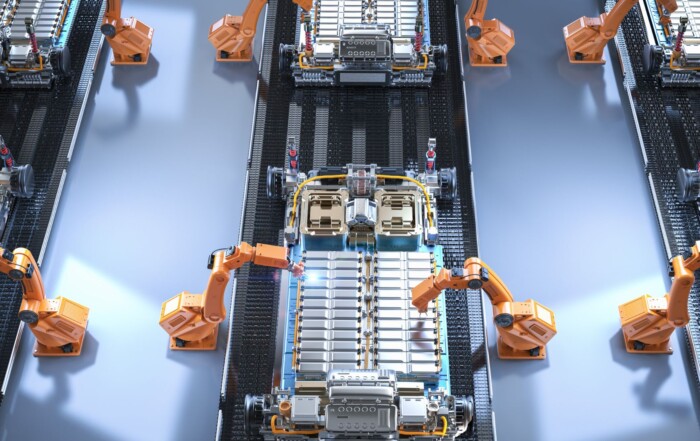Three questions about the iSYS-6030 distance measurement radar system
Answered by Maximilian Dötsch, Junior Product Manager at InnoSenT
Once again, InnoSenT has exciting product news to share: the ISYS-6030 stands out significantly from the rest of the industrial sensors in the InnoSenT portfolio. It is not 24 GHz but instead uses a 60 GHz frequency band. This characteristic is important to the system’s areas of application. During its development, the radar experts drew on their experience, and an older product served as the basis for the product design. Now, the new system is replacing its successful predecessor, the iSYS-6003. It was time for a technical update – because even a classic can be optimised. In a short interview, Maximilian Dötsch, Junior Product Manager at InnoSenT, explains what the ISYS-6030 can do better and what special features it boasts.
What is the ISYS-6030 sensor used for and what was the motivation for developing this product?
MD: The ISYS-6030 is a 60 GHz radar and is primarily used for distance measurement. The sensor has FMCW modulation and detects stationary and slow-moving objects. Its specifications make it predestined for two areas of application. Like its predecessor, it is used for determining filling levels. However, through the technical update, it is also suitable for avoiding collisions. Sporadic and very precise measurement is important for these applications. Thanks to its lens and antenna design, the sensor thus has an intensely focused beam with an aperture angle of 6° in azimuth and elevation. The product only outputs the distance information about an object and its signal strength in dB via a target list. Further measurement results, such as speed, are not relevant for these applications. The ISYS-6030 is therefore in use solely as a distance sensor. For example, it determines the filling level in silos or prevents two objects from colliding.
We always strive to make our products even better. But the crucial point for us to take the time to overhaul the iSYS-6003 had actually not yet come. A supplier informed us about a change to component which would make its availability in the future uncertain. So we had to make changes. We immediately seized the opportunity to optimise the product and launched a development project. After a few years of practical experience and further progress in the field of radar technology, we had gathered some insights. For instance, we are now able to achieve better performance at a lower price. In addition, with the new product, we have addressed customer needs and application requirements even better.
The technical innovations are noticeable in many ways. The ISYS-6030 is more precise thanks to its better resolution and has an even more focused detection range. The measuring cycles are significantly faster, which keeps power consumption low and increases efficiency. The range has also been more than doubled, enabling the sensor help avoid collisions. We offer greater flexibility due to a wider range of supply voltages and four digital, individually configurable outputs. In the software’s GUI, the customer has numerous filtering and customisation options. The GUI also provides a practical visualisation that makes the fill level measurement or safety distance easy to keep track of. Of course, we have provided the technical data in a data sheet in our download portal.
How does the product determine the fill level or protect against collisions?
MD: The product enables distances to be measured completely without contact. The antenna of the ISYS-6030 emits HF waves which the lens focuses into a narrow radar beam, specifically detecting objects within a range of up to 40 meters. The emitted radar waves hit an object and are then reflected back to the sensor. The ISYS-6030 uses the response signal to process information about the distance and signal strength of the detected object.
For example, when used for fill level measurement, the product is mounted at the top, on the lid or the roof of a silo, and points downwards. Users can adapt the range of the sensor to the size of the tank. It therefore indicates the maximum distance from the antenna to the silo floor and the exact position of the sensor. When the container fills up, the ISYS-6030 records the change in distance. The new value corresponds to the amount filled – because the system then receives the response signal from the surface of the filling material instead of from the bottom of the silo. The detection process works independently of the type of material – regardless of whether it is a solid or fluid. The product also has two different operating modes. In single-target mode, the sensor measures only the position of a target object. In multi-target mode, the iSYS-6030 detects up to ten target objects and can, for example, calculate the average distance based on several measuring points. The operating principle is similar for collision avoidance. For example, the product might be attached to a crane that moves on a rail. Here, the sensor constantly determines the distance information within the detection range. If an object appears there, the distance information changes. This data is important for triggering a signal and thus an action when the safety distance is too low or there is a risk of an impending collision. Especially with autonomous vehicles, in environments with high safety standards and in unclear situations, this constitutes an important protective measure for devices as well as for people.
Why is the radar sensor ideal for these applications and distance measurement?
MD: Radar is a tracking procedure and provides all relevant data for determining the position of objects. This includes the distance information we need for measuring distances. The technical features of the iSYS-6030 are specifically adapted to the application requirements and determining distances.
The iSYS-6030 operates in the 60 GHz frequency band. This enables the use of a greater bandwidth and provides better resolution and differentiation of objects compared to sensors in the 24 GHz frequency range. In addition, our developers have managed to achieve a high degree of measurement accuracy. This ensures higher-precision measurement results and achieves a low deviation of just ±0.1 percent over the distance – even at a distance of 40 meters. This degree of measurement accuracy is impressive and represents a crucial requirement for collision protection and fill level detection.
Radar boasts the ideal conditions for such measuring tasks. Because the technology is very robust and reliable. This makes the iSYS-6030 well-equipped for outdoor use and maintenance-free. Where wind, rain, snow, or frost prove challenging for other measurement methods, this radar sensor continues to function perfectly. Another advantage is that even vibrations and extreme temperatures do not impair radar detection. Foam, fog, dust, or mist that might occur while a fill level is being determined do not distort the measurement result. The iSYS-6030 provides high-quality data in a difficult measurement environment and is InnoSenT’s radar solution for detecting fill levels and distances.
Thank you for this interview!
picture: ©Zagest Roman by adobe stock


